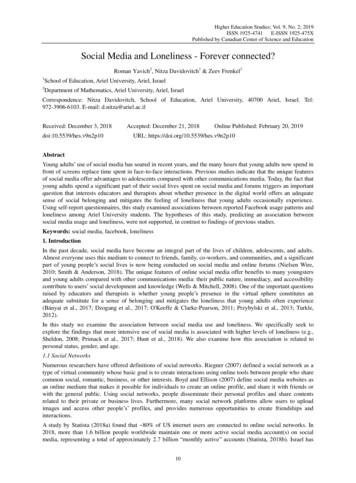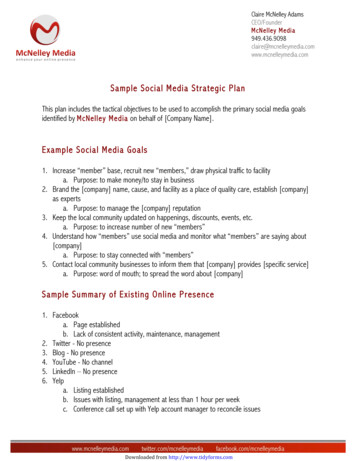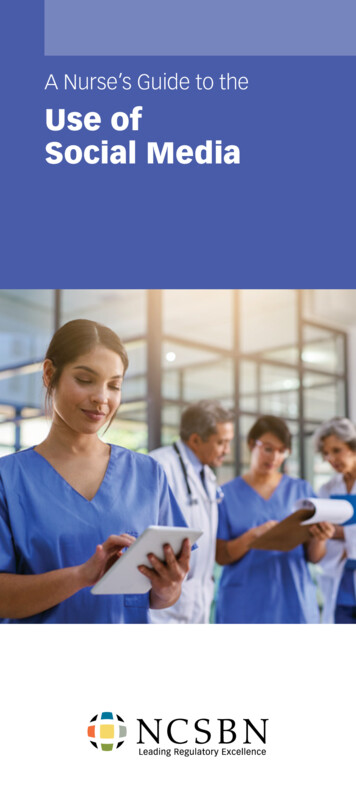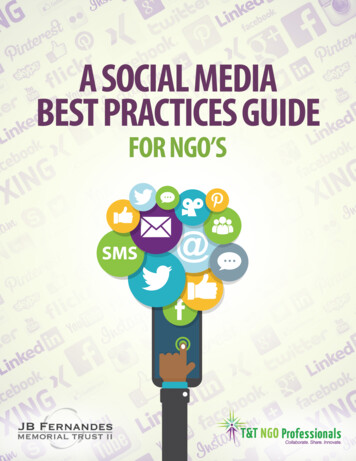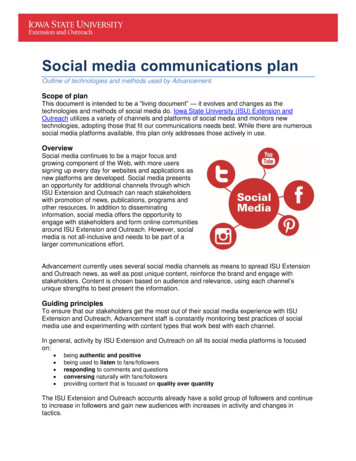
Transcription
ISSN 1798-4769Journal of Language Teaching and Research, Vol. 11, No. 3, pp. 373-378, May 2020DOI: http://dx.doi.org/10.17507/jltr.1103.05The Effectiveness of Social Media Application"Telegram Messenger" in Improving Students’Reading Skills: A Case Study of EFL Learners atAjloun University College/JordanMuntaha Ali Mohammad Al MomaniDepartment of English, Ajloun University College, Al Balqa Applied University, JordanAbstract—With the advent of smart phones and new smart devices, the use of these mobile communicationdevices has become an integral part of our daily life. The study aims to discuss the influence of moderntechnological apps in developing students' skills such as telegram messenger channels on improving readingskills E-leaning, m-learning and techno-aids might help to fill the gap. The study is conducted on EFL learnersat Ajloun University College. To sum up, the study has provided evidence to the effectiveness of Telegram social media application in improving students' reading skills.Index Terms—English as a Foreign Language, reading skills, smart phones role in education, social mediaapplications, Telegram MessengerI. INTRODUCTIONNowadays, the world is in the era of social media revolution, the age of smart phones and smart devices applications.We use phone devices not only for communications with others, but for a variety of other purposes, as well. Actually,with the advent of smart phones and new smart devices, the use of these mobile communication devices has become anintegral part of our daily life. Today, people from all ages have the ability to use smart devices applications, includingyoung students anytime anywhere (Cook & Das, 2007).The students prefer the utilization of their mobile devices to access the internet and conduct learning related activities.(Wong, 2015)The new generation of young students has technical, electronic and digital minds. They deal with the new technologyas a piece of cake. In fact, they are fully aware of the globalization and part of it (Bolstad, & Gilbert, 2006). They spendmost of their time working on their smart phones. By time, such students lose enthusiasm to learn from regular booksand traditional curriculums with the prevalence of the social media, the smart phones and smart devices applications.However, over a period, these mobile apps are playing significant role in the day-to-day lives including education.These phone applications have made our life simpler and have provided yet another innovative way of accessingeducation. In fact, "these profound changes are placing increasing pressure on the traditional models of teaching andlearning."( Bansal & Dhananjay Joshi, 2014). Thus, our students deserve better when it comes to education. E-leaning,m-learning and techno-aids might help to fill the gap. Actually, there is a shift to e-learning that is enabled bycommunication technologies (Campbell, 2010).In fact, the world has seen a steady and rapid increase in the growth of phone applications, since the appearance ofthe Apple App Store in 2008. Varieties of smart phones applications are currently available. However, among the toplists in the popular applications given by various sources, a prominent name that is emerging all over the globe isTelegram. Telegram messenger is a mobile application that has apparently caught the attention of large number ofmobile users (Giordanoet al, 2015).Mobile assisted learning (MALL) can be defined as the use of small, portable, wireless devices such as mobilephones, smartphones and personal computers to achieve flexibility and interaction in teaching and learning anytime andanywhere (Mehmadi, 2012).Digital devices, mobile phones and Tablet PCs can be used to perform many educational tasks, although their rolediffer. Most mobile devices are useful in teaching, facilitating teachers’ tasks and considered as learning aids forstudents as illustrated by the following (Kasem et al., 2006):Students can interact with each other and with the teacher instead of hiding behind the large monitor.Many portable devices in the classroom are easy to be installed compared to desktops that require a lot ofspace.Most personal digital devices, notebooks, tablets, and smart phones are lighter, smaller and easier to carry thanbags filled with files, books or any paper study material.Handwriting recognition applications in personal portable devices help in improving students’ handwriting 2020 ACADEMY PUBLICATION
374JOURNAL OF LANGUAGE TEACHING AND RESEARCHskills.Increase motivation and personal commitment to learning if the student will take the device home at any timehe wants, it helps him to commit and take responsibility.Attract learners: young people who have dropped out of education can enjoy the use of mobile devices.Mobile assisted learning could help the English language teachers by saving time through enabling them to transmiteducational information to the class students in an effective manner.Regarding the classroom activities, teachers could utilize the mobile applications to explain the English languagegrammatical rules which will be more effective than writing the rules on the blackboard (Dajani and Wahba, 2001).The introduction of mobile assisted learning in teaching English language in the private and public schools in theKingdom of Saudi Arabia could be useful. Therefore, the integration of educational technologies in the schools isprobably a very important issue of concern to the policy makers in the Saudi ministry of education (Mehmadi, 2012).Telegram messenger is a cloud-based mobile and desktop messaging application with a focus on security and speedwhich was launched on August 14, 2013 to make communication and the distribution of multimedia messaging moreeasily and faster. “Telegram Messenger is a messaging application focusing on instant and secure messaging, it’s superfast, simple and free. Individuals can download Telegram on all portable devices at the same time— and synchronizetheir conversations seamlessly across any number of your devices." (Telegram .com, 2017).Nowadays, millions of people are using Telegram. That's nearly one in seven people in the world who use Telegrammonthly to keep connected with their loved ones, friends and family.( Telegram Blog, 2017). Telegram is supportedfinancially and ideologically by Pavel and technological by Nikolai Durov.Using Telegram messenger in English language learning had positively affected the students’ comprehension ofvocabulary and grammatical rules (Alkhezzi & Al-Dosari, 2016)Since Telegram is relatively a new phenomenon, little research exists regarding its influence on interpersonalcommunication in general, and between high school teachers and their students in particular (Church & de Oliveira,2013). While reviewing the literature of the topic of this study, few references and books were found tackling the issueof Telegram messenger from the pedagogical perspective. Most of the information found was in the form of articles,researches, or thesis. Most of the writers' arguments of these works lead to the recommendation to adopting Telegram asa perfect educational assistant. Yet, on the other hand, there are others who have not the same attitude towards theapplication.-II. REVIEW OF RELATED LITERATUREHere is a review of the views of some of the writers who recommend using Telegram as an effective and successfulteaching-learning aid as well as others of the contrasted team.Digital communication between groups of students and between students and teachers has become popular during thelast decade through various channels: Email, SMS, Facebook groups, Twitter, Whatsapp and recently Telegram. Eachone of these tools has different characteristics that influence its suitability for learning purposes. (Calvo, Arbiol andIglesias, 2014).Previous studies examined different use of Telegram in educational settings. One study investigated the effectivenessof using Telegram in teaching English pronunciation to Iranian EFL learners. Study participants had included 30 IranianEFL learners divided into an experimental group (N 14) and a control group (N 16). Study groups had receivedvarious treatments over a period of 4 weeks. Study findings for the pre and posttest had indicated that there is asignificant improvement in the pronunciation of participants in the experimental group compared to the control group.Study had concluded that utilizing Telegram messenger in teaching English language is an effective and promisingapproach (Xodabande, 2017).In a study conducted by Zarei et al (2017) that aimed to investigate the impact of using Telegram on EFL learners’and the knowledge and attitudes of them towards vocabulary learning. Study sample had been composed of 100 EFLlearners that were involved in a quasi-experimental study. Participants were divided into two study groups; the controlgroup (N 50) and the experimental group (N 50). Both group members had received a three weeks vocabularyinstruction. Experimental group members had been asked to fill out a pre-designed questionnaire. Finally, a vocabularytest had been administered among the participants of the both groups. Study findings had shown that there is asignificant outperformance of the experimental group over the control group. Furthermore, study findings had shownthat the study participants had positive attitudes toward using Telegram messenger.Many studies had investigated the impact of similar mobile applications such as Whatsapp on the learning outcomes.For instance, a study conducted by Bansal et al(2014) aimed to investigate students’ experiences of Whatsapp mobilelearning , during session 2013-2014 , and examined a sample of 37 Bachelor of Education students. Study samplestudents and their teacher were interacting with each other within Whatsapp group and finally students were asked tofill in a pre-designed questionnaire. Findings of the study had showed an increase in students’ social interactivity andthey learned collaboratively, as well as Whatsapp was favorable for students. Moreover, study results indicated thatmarried students considered that learning using Whatsapp is disruptive and they prefer traditional classroom learning.III. OBJECTIVES OF THE STUDY 2020 ACADEMY PUBLICATION
JOURNAL OF LANGUAGE TEACHING AND RESEARCH375As a teacher of English for years, the researcher realized that learning has changed from a mere repetition andmemorization of facts to interactive strategies of learning. This study is conducted for three main reasons. Firstly, tohave students and teachers get out of the monotonous and boring class atmosphere and to experience other liveinteractive atmosphere, whether inside or outside the classroom . Secondly, to identify the impact of using Telegram asa mobile learning tool on reading skills of undergraduate EFL learners at Ajloun University College. This study will gothrough new teaching-learning methods that are more appropriate and suitable for students' interests and preferences soas to provoke their awareness towards the content being learned.IV. PROBLEM OF THE STUDYThis study came to address two major problems. Mainly, formal learning that is widespread in our schools does notallow the design of authentic learning tasks. Also, mobile phones are hardly used for teaching and learning in thelearning settings. Moreover, though our students become so fond of their smart phones to the extent that they cannotlive without. Thus, it becomes a must for us to adopt new techniques including mobile apps. Telegram, as a verypopular social media application among students, may solve the problem.V. RESEARCH QUESTIONSThis study is conducted mainly to answer the following major question:Are there any significant statistical differences at significance level (α 0.05) between the Control group and theexperimental group in the reading post-test referred to using Telegram Messenger channels?VI. SIGNIFICANCE OF THE STUDYThis study is considered important as follows1.Theoretical significance: current study will provide good literature regarding the impact of using Telegrammessenger channels on English language learners’ reading skills.2.Practical significance:For teachers and instructors: it will provide a new educational method that will improve students’reading skills.For college administration: The findings of the current study will enable the administrative authoritiesand decision makers in the educational institutions to have a reference for the formulation of theeducational policies.VII. METHODOLOGYThis study is designed to investigate the impact of Telegram messenger channels usage on improving reading skillsof undergraduate EFL learners in Ajloun College University.Setting: A quasi-experimental approach that is represented by a pre and post-test over two students groups (Anexperimental group and a control group) will be adopted in this study.Population and sampling: The population in the current study was the 2nd year Jordanian EFL learners registered asregular students in Ajloun University College following Al-Balqa’a applied university, and enrolled in the reading skillscourse in the first semester of the academic year 2019/2020.Purposeful sampling was performed to get the study sample; the researcher intentionally selected two classes torepresent the study sample. Each class consisted of 35 students. Class A represented the control group whereas theClass B represented the experimental group.Data collection toolsThe researcher designed the reading skills’ test that was used in this study as an assessment tool for participants’reading skills. The reading skills test was designed through identifying the objectives of the test and analyzing thecontent of the teaching material presented in the reading curriculum studied by 2nd year EFL learners. Briefly, theresearcher followed the following procedure in constructing the reading pre/posttest before releasing it in the final form:Determining the general aim of the test: As this test aims at measuring the level of reading skills of the 2ndyear undergraduate EFL learners in Ajloun College University.Reviewing the literature and previous local and international studies that investigated the reading skills of theEFL learners. The purpose of this step was to get use of the standard procedure of constructing a reading skillspre and post-test.Analyzing the content of the teaching material presented in the reading curriculum that is studied by 2nd yearEFL learners in Ajloun University College. This was performed in order to set the description of the test anddetermine the items of the test.Setting the instructions of the test: The researcher prepared the instructions of the test that included the aim ofthe reading test, the number of items, and the time allotted to answer the test items.Preparation of the first version of the reading skills test: after determining the reading skills that were needed 2020 ACADEMY PUBLICATION
376--JOURNAL OF LANGUAGE TEACHING AND RESEARCHto be improved among 2nd year EFL learners at Ajloun University College, the researcher constructed the firstversion of the reading pre/post-test. The first version consisted of one reading passage with 20 itemsValidating the reading test: the researcher submitted the reading test to a panel of jury members who wereasked kindly to review the reading test in terms of the clarity of the language, the comprehensiveness of thetest items and to provide any useful comments that might improve the reading test.Measuring the reliability of the test: To ensure the reliability of the test, the researcher used the test-retestmethod by administering the reading test on a pilot sample consisted of 20 EFL learners with a time intervalbetween the first and second administration of two weeks. Pearson’s correlation factor was calculated to be(0.91) which is acceptable in educational research.VIII. PROCEDURE FOR THE E XPERIMENTAL AND CONTROL GROUPParticipants of the experimental group were required to provide the researcher with their phone numbers. Then, theywere trained to run the application on their smart phones and joined the online learning group.Previous procedure was performed to make the students familiar with the outline group and things they needed to beinvolved in the learning process.Before proceeding in the study, the researcher had held an introductory session for the experimental group to give abrief summary about the study and its benefits to the teaching and learning processes.Data collection procedure had started, it had been performed over a period of four weeks (15 sessions including theintroductory session). Students had attended their classes and committed to follow the normal activities of the class.Each online learning session had included posting the studied lessons’ vocabularies and reading exercises. Posteddata could be reviewed by the group members.Thus, the experimental group members had been involved in one hour traditional class at the college, three onlinesessions weekly on Mondays, Wednesdays, and Thursdays. Furthermore, the online participation was not restricted to aspecific time, students could post their questions to be answered by the teacher.After 14 sessions of using Telegram online learning environment, study participants had been tested for their readingskills.On the other hand, participants of the control group had received a traditional learning in the classroom context.IX. DATA ANALYSISData from the pre and post reading tests were be compiled, sorted, coded and imported to Excel sheets , and finallycalculated using Statistical Package for Social Sciences (SPSS) in order to perform the statistical analysis such asfrequencies , mean , standard deviation , and correlation coefficients analysis . Independent samples t-test and One WayANOVA were used to identify the differences in reading performance among the control and the experimental groups.X. RESULTS AND DISCUSSIONThe current study aimed at investigating the impact of using Telegram messenger channels on improving readingskills among 2nd year EFL learners at Ajloun University College.Means and standard deviations of the study participants in reading pre and post-test were calculated for both studygroups (the experimental and the control).It is obvious from table (1) that there are apparent differences between the mean scores of the participants in readingpre and post-test based on the study group (experimental and control).TABLE (1):MEANS AND STANDARD DEVIATION SCORES FOR THE STUDY PARTICIPANTS’ SCORES IN THE READING SKILLS PRE AND POST-TEST ACCORDING TOTHE GROUP (EXPERIMENTAL AND CONTROL)Post testPre 613.8535Control1.37315.562.05913.7770TotalTo identify in favor of which group these differences are referred, the researcher used One Way ANCOVA test afterneutralizing the pre-test measurements for the groups.Table (2) shows that there are significant statistical differences at significance level (α 0.05) in the scores of thestudy participants in the reading test according to the study group (experimental and control), the F value was 93.068with a significance value (0.000), which is statistically significant, and this revealed the effect of the study group. 2020 ACADEMY PUBLICATION
JOURNAL OF LANGUAGE TEACHING AND RESEARCH377TABLE (2):ONE WAY ANCOVA TEST RESULTS FOR THE READING SKILLS POST-TEST ACCORDING TO THE STUDY GROUP (EXPERIMENTAL, CONTROL) AFTERNEUTRALIZING THE EFFECT OF THE PRE-TEST MEASUREMENTSEta squareMean of sum FreedomSumofSigF valueVariation 35.421Pre 67204.461Error69475.826TotalIn addition, it is clear that the teaching method effect was large, the Eta square value that was 56.1% explained thepredicted variation in the dependent variable that is the reading skills test.Estimated means and estimated standard errors were calculated for the study group in order to determine the directionof the significant differences (Table 3)TABLE (3):ESTIMATED MEANS AND ESTIMATED STANDARD ERRORS FOR THE READING SKILLS ACCORDING TO THE STUDY GROUP (EXPERIMENTAL, CONTROL)Modified standard errorModified Post mean scoreGroup.23517.20Experimental.24613.93ControlThe results shown in table (3) indicated that the significant differences were in favor of the experimental groupmembers that were exposed to Telegram messenger channels compared to the control group members who wereinstructed traditionally.The previously presented results are attributed to the Telegram social audio platform that enables learners to receivelessons via text or voice messages, as well as the possibility of uploading videos and photos, which in turn reduces thedirect communication between the teacher and the learner as in the classroom, which reduces the degree of learninganxiety of English learners. In addition, the services provided by the social networking platform (Telegram) allow thelearner to participate actively in the discussions that take place between the teacher and other colleagues, which in turncontributes to the development of linguistic wealth of students and thus reflected positively on their language skills,especially reading skill. This result may also be attributed to the presence of direct feedback, and immediate individualand group guidance during the learning process, because untargeted repetition of the material leads to fixation in themind of the learner, and the learning environment in which audio-visual methods are used in the Telegram platformmay be stimulating, Especially for students who are ashamed of the classroom.XI. CONCLUSIONIn conclusion , the study has provided an evidence to the effectiveness of Telegram social media application inimproving students' reading skills due to the different services it provides , such as the ability to introduce audio-visualtopic explanation , besides to motivating students to search for knowledge and information independently , which pointsout to the key role of Telegram application in creating a student-centered educational environment that is compatiblewith the modern learning theories that concentrate on the importance of students motivation and activation of studentsrole to participate in an effective educational process to achieve the desired outcomes .XII. SUGGESTIONS FOR FURTHER RESEARCHBased on the findings and the limitations of this study, I recommend the following suggestions for further research1. To include various educational stages in the upcoming studies in order to cover wider slice of the educationalenvironment elements.2. Extend the study geographical borders, which will help harvesting more accurate and general findings.3. Investigate the effect of various demographic factors such as gender, age, parents’ educational level, etc.4. Perform studies that include the implementation of a guidance activity of how to utilize social media tools in theeducational process.5. Involve the familiar learning approaches and theories along with the investigation of social media tools such asimplementing a cooperative learning approach based on the usage of Telegram application in the learningprocess, and application of constructivism theory concepts in the learning process.APPENDIXCloze TestA can't beB must beC will be18- I often get .watching TV because the programmers are so boring.A sleepB sleepyC sleeping19- What are you doing? I'm .this man talking about Modern art. 2020 ACADEMY PUBLICATIOND wasD asleep
378JOURNAL OF LANGUAGE TEACHING AND RESEARCHA listenB hearing20- The driver was fined for having .the speed limit.A exceededB excessiveC listening toC excessD hearing fromD 0][11][12][13][14][15][16]Aldosari, H. (2016). Effects of integrating reading and writing during the reading process on EFL English writing in a Saudicollege course: a quasi-experimental study. In First International Forum on Academic Teaching: Social Inclusion andInformation and Communication Technology, 3rd to 5th October. Alkhezzi, F., & Al-Dousari, W. (2016). The Impact of Mobile Learning on ESP Learners' Performance. Journal of EducatorsOnline, 13(2), 73-101.Bansal, D., &Dhananjay Joshi, T. (2014). A Study of Students Experiences of Whats App Mobile Learning. Global Journal ofHuman-Social Science Research, 14(4), 18-36. Bolstad, R., & Gilbert, J. (2006). Creating digital age learners through school ICT projects: What can the Tech Angels projectteach us. Education Counts, 13 (4), 31-52. Calvo, R., Arbiol, A., & Iglesias, A. (2014). Are all Chats suitable for learning purposes? A study of the required characteristics.Procedia Computer Science, 27, 251-260. Campbell, S. W., &Kwak, N. (2010). Mobile communication and civic life: Linking patterns of use to civic and politicalengagement. Journal of communication, 60(3), 536-555.Church, K., & de Oliveira, R. (2013, August). What's up with whats app?: comparing mobile instant messaging behaviors withtraditional SMS. In Proceedings of the 15th international conference on Human-computer interaction with mobile devices andservices (pp. 352-361). ACM. Cook, D. J., & Das, S. K. (2007). How smart are our environments? An updated look at the state of the art. Pervasive andmobile computing, 3(2), 53-73. Dajani, D. & Wahba, N. (2001). The difficulties that hinder the use of the Internet as an educational tool in Palestinian schools.Paper presented at the Educational Process in the Internet Age, Palestinian. Journal of Educational sciences, 14(1), 15-28.Giordano, V., Koch, H. A., Mendes, C. H., Bergamin, A., de Souza, F. S., & do Amaral, N. P. (2015). Whats App messenger isuseful and reproducible in the assessment of tibial plateau fractures: Inter-and intra-observer agreement study. Internationaljournal of medical informatics, 84(2), 141-148. Kassem, M., Zeinab, A. & Liz, E. (2006). Handbook for Arabic language teaching professionals in the 21st century (pp. 4, 241,242, 244 & 295-299). Mahwah, New Jersey: Lawrence Erlbaum.Mehmadi, R. (2012). The levels of Arabic language female teachers ability in efficiencies of elearning to teach it in a highschool in the Holy Capital. (Unpublished Master Thesis), Umm Al Qura University, Makkah.Smith, T. (2009). The social media revolution. International journal of market research, 51(4), 559-561. Wong, K., Wang, F. L., Ng, K. K., & Kwan, R. (2015). Investigating acceptance towards mobile learning in higher educationstudents. In Technology in Education. Transforming Educational Practices with Technology (pp. 9-19). Springer BerlinHeidelberg. Xodabande, I. (2017). The effectiveness of social media network telegram in teaching English language pronunciation toIranian EFL learners. Cogent education, 4(1), 1347081. Zarei, R., Heidari Darani, L., & Ameri-Golestan, A. (2017). Effect of Telegram Application on Iranian Advanced EFLLearners' Vocabulary Knowledge and Attitude. International Journal of Foreign Language Teaching and Research, 5(20), 96109. Muntaha Ali Mohammad Al Momani was born in Irbid city in Jordan on 16th of December 1979. She received her B.A inEnglish for Specific Purposes from Jordan university of Science and Technology in 2001, and M.D in English Teaching Methodsfrom Al-hashimia university in 2005.She is an instructor in Al-Balqa Applied University, Ajloun University College, Department of English. She taught Mandatorycourses as English (099), English (101), and English (102), moreover she taught skills like writing, reading, and speaking.Here research focuses on the "Effectiveness of social media application telegram messenger in improving students reading skil ls" 2020 ACADEMY PUBLICATION
social media application in improving students' reading skills. Index Terms—English as a Foreign Language, reading skills, smart phones role in education, social media applications, Telegram Messenger I. INTRODUCTION Nowadays, the world is in the era of social media revolution





